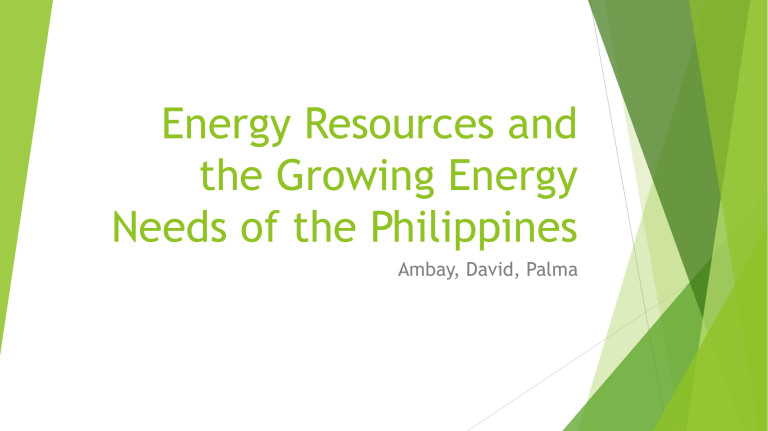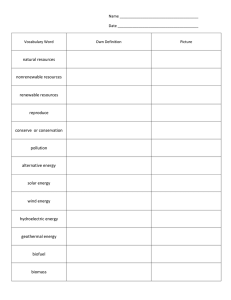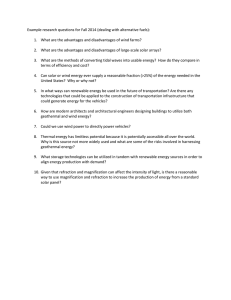Energy Resources and the Growing Energy Needs of the Philippines
advertisement

Energy Resources and the Growing Energy Needs of the Philippines Ambay, David, Palma Report Outline I. Energy Sources II. Energy Resources Policies and Programs III. Growing Energy Needs Types of Energy Sources Renewable Energy Renewable Energy is one of the energy sources in the Philippines. It is defined as energy sources that are constantly being replenished which means we can use it as much as we want without them being depleted. These energy sources are usually much more environmentally friendly than other sources of energy like fossil fuels. Solar, wind, hydropower, geothermal, and biomass are renewable energy sources that are being used in the country. Solar Energy Solar energy is one of the most promising sources of energy and its share in the global energy mix has steadily increased over the past several years. In the past years, despite its huge potential, the Philippines is lagging behind in terms of policy implementation and deployment of solar energy as its main source. Throughout the years, the Philippines was able to implement the use of solar energy as one of its main source of energy. Although the country is still young when it comes to solar development, it was able to get seven active projects. According to a Dutch consultancy firm, the Philippines ranked No. 1 among the developing countries in Asia in terms of the use of photovoltaic systems for electricity generation. It also ranked fifth worldwide following Chile, South Africa, Brazil, and Thailand. Cadiz Solar Power Plant – 132.5 Mw of solar energy Wind Energy The Philippines has overtaken all other members of the Association of Southeast Asian Nations in terms of installed wind energy capacity. The country now has an operational wind energy capacity of 427 MW, which is in par with other Asian countries. Although it is in par with other Asian countries, it is still relatively low when compared to the Western countries. In its National Renewable Energy Plan 2012 - 2030, the Philippines has set the goal of adopting an additional 1,548MW of renewable energy by 2030. A breakdown of this reveals that wind power will account for the greatest share of this at 38% (593MW). Burgos Wind Farm – 150 MW of wind energy Hydropower/Hydroelectric Hydropower is one of the best renewable energy because it is always available and does not depend on the current weather or climate of a place. Hydropower helped the Philippines faced its need for more power. There are many hydroelectric power plants in the country one of which is the Magat hydropower plant that helped the country’s energy shortages by attracting foreign and local investors. Ever since then, private sponsors have pledged to invest more in the Philippines power sector which helped the country avoid electricity shortages. Magat Dam– 360 MW Biomass The Philippines has abundant supplies of biomass energy resources in the form of agricultural crop residues, forest residues, animal wastes, agro-industrial wastes, municipal solid wastes and aquatic biomass. The most common agricultural wastes are rice hull, cane trash, and coconut shell/husk. Rice hull is perhaps the most important, underdeveloped biomass resource that could be fully Biomass energy plays a vital role in the nation’s energy supply. utilized in a sustainable manner. Biomass energy application accounts for around 15 percent of the primary energy use in the Philippines. San Carlos BioPower – 19.9 MW Geothermal The Philippines is one of the world's top producers of geothermal power because of its location along the Pacific Ring of Fire. Even though its in the top producers of geothermal energy, the country has not seen any geothermal development since the enactment of the Renewable Energy Act of 2008, which dislodged the Philippines from the second top spot in terms of capacity generated from the resource. It is one of the renewable energy developments that could provide baseload, or 24/7 power supply. The other is hydropower. Malitbog Geothermal Plant – 232.5 MW Types of Energy Sources Non-Renewable Energy Sources


